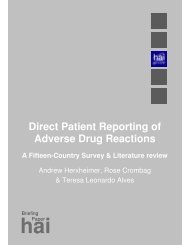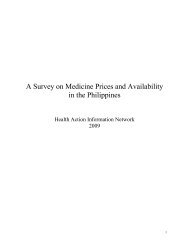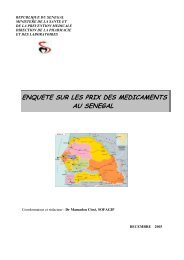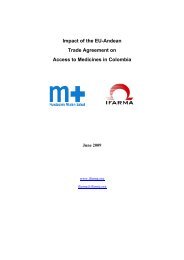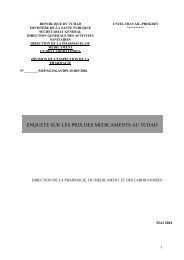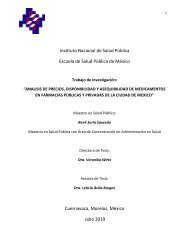Comprender la promoción farmacéutica y responder a ella - Multiple ...
Comprender la promoción farmacéutica y responder a ella - Multiple ...
Comprender la promoción farmacéutica y responder a ella - Multiple ...
- No tags were found...
Create successful ePaper yourself
Turn your PDF publications into a flip-book with our unique Google optimized e-Paper software.
Capítulo 4 - Los visitadores médicos | 83ReferenciasAdair RF, Holmgren LR (2005). Do drug samples influence resident prescribing behavior? A randomized trial.American Journal of Medicine, 118(8): 881-884.Asundaria, P (2009) Pharma marketing – but how? (http://members.tripod.com/pharmapage/tips9.htm, se tuvoacceso el 17 de abril de 2009).de Bakker DH, Coffie DS, Heerdink ER et al. (2007). Determinants of the range of drugs prescribed in generalpractice: a cross-sectional analysis. BMC Health Serv Res. Aug 22,7:132 (http://www.biomedcentral.com/1472-6963/7/132, se tuvo acceso el 17 de abril de 2009).Barde<strong>la</strong>y D, Bécel D (1995). Visits from medical representatives: Fine principles, poor practice. Prescrire International,4(18):120-122.Brennan TA, Rothman DJ, B<strong>la</strong>nk J et al. (2006). Health industry practices that create conflicts of interest. A policyproposal for academic medical centers. Journal of the American Medical Association, 295(4): 429-433.Brody H (2005). The company we keep: Why physicians should refuse to see pharmaceutical representatives.Annals of Family Medicine, 3: 82-86.Chren MM, Landefeld CS (1994). Physicians' behavior and their interactions with drug companies. A controlledstudy of physicians who requested additions to a hospital drug formu<strong>la</strong>ry. Journal of the American MedicalAssociation, 271(9):684-689.Cialdini RB (2000). Influence: science and practice. 4th ed. New York, Allyn and Bacon.Coyle SL (2002). Physician-industry re<strong>la</strong>tions. Part 1: Individual physicians. Annals of Internal Medicine, 136:396-402.Dana J, Loewenstein G (2003). A social science perspective on gifts to physicians from industry. Journal of theAmerican Medical Association, 290(2):252-255.Day R (2000). How to make the most of a visit from a pharmaceutical company representative. Australian Prescriber,23: 97-99.Doran E, Kerridge I, McNeil P et al. (2006). Empirical uncertainty and moral contest: a qualitative analysis of there<strong>la</strong>tionship between medical specialists and the pharmaceutical industry in Australia. Social Science & MedicineMar;62(6):1510-9).Dubois RW (2003). Pharmaceutical promotion: Don’t throw the baby out with the bathwater. Health AffairsSupplement, sólo en Internet: W3-96-103.Katz D, Cap<strong>la</strong>n AL, Merz JF (2003). All gifts <strong>la</strong>rge and small: Toward an understanding of the ethics of pharmaceuticalindustry gift-giving. American Journal of Bioethics, 3(3):39-46.Komesaroff PA, Kerridge IH (2002). Ethical issues concerning the re<strong>la</strong>tionships between medical practitioners andthe pharmaceutical industry. Medical Journal of Australia, 176(3):118-121.Lam MD (2004). A $20 billion bill and plenty of change. Pharmaceutical Executive Sept 1.Lexchin J (1997). What information do physicians receive from pharmaceutical representatives? Canadian FamilyPhysician, 43:941-945.Lexchin J (2001). Interactions between doctors and pharmaceutical sales representatives. Canadian Journal ofClinical Pharmacology, 8(2): 64-65.MacKinnon NJ (2004). Use of samples as a threat to seamless health care. American Journal of Health SystemsPharmacy, 61:1497-1500.




